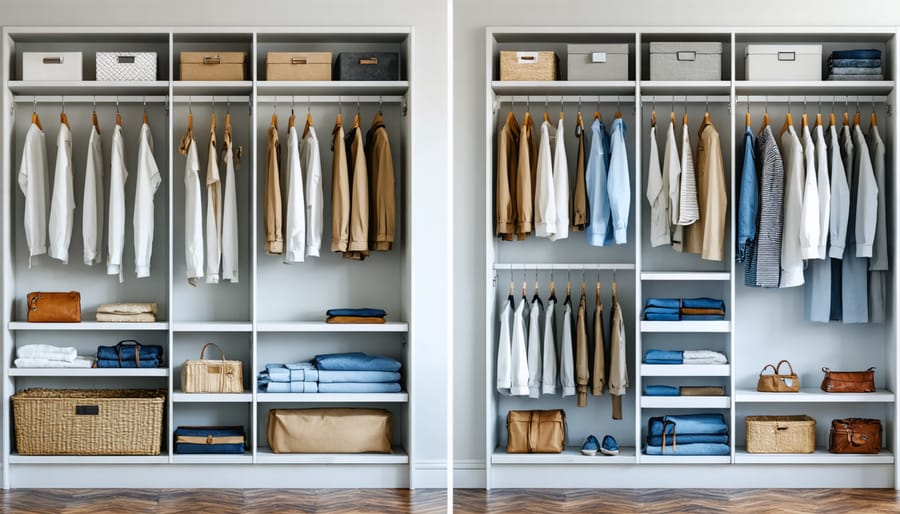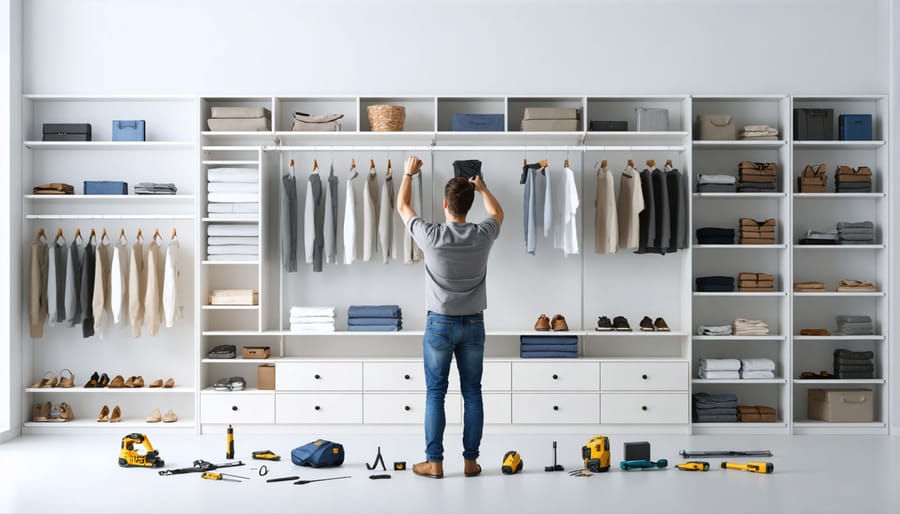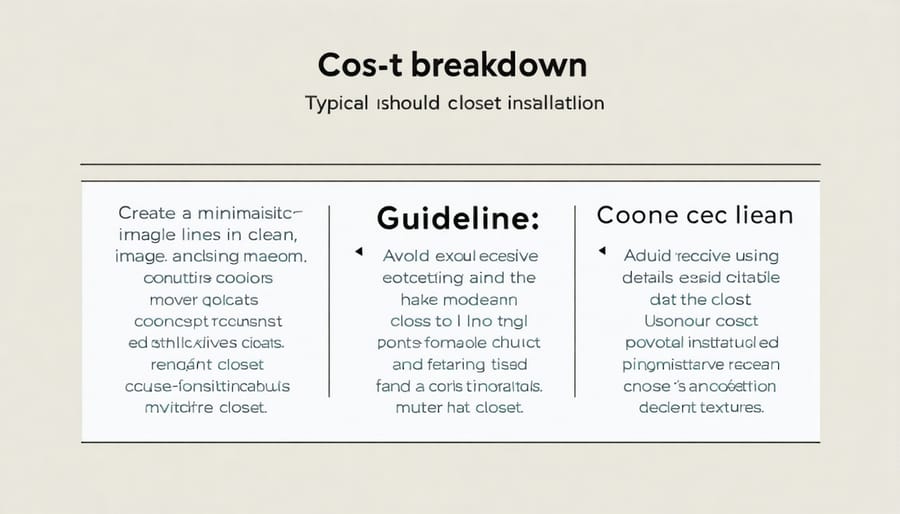Transform your closet space with professional organization solutions ranging from $200 for basic DIY kits to $6,500+ for custom built-ins – but don’t let those numbers intimidate you. Smart planning and strategic choices can dramatically reduce your investment while still achieving magazine-worthy results. Whether you’re revamping a reach-in closet or designing a luxury walk-in, understanding closet renovation costs empowers you to make informed decisions that balance your vision with your budget. Most homeowners spend between $1,000 to $3,000 for a mid-range closet system, including materials and installation, with the final price depending on size, materials, and design complexity. By breaking down these costs and exploring money-saving alternatives, you’ll discover how to create your dream closet without breaking the bank.

Understanding Closet Kit Price Ranges
Budget-Friendly Options ($100-$500)
Budget-conscious homeowners can create functional and attractive closet systems without breaking the bank. Wire shelving systems typically start around $100 for a basic 6-foot closet setup and offer remarkable versatility. These systems include essential components like hanging rods, shelves, and basic organizers, making them perfect for starter homes or rental properties.
For those seeking a more polished look, laminate systems begin around $300 and offer a significant upgrade in appearance. These pre-fabricated units often feature a wood-like finish and come with adjustable shelving, drawers, and hanging spaces. Many big-box retailers offer affordable laminate closet kits that you can install yourself, saving significantly on labor costs.
Pro tip: Maximize your budget by mixing and matching components. Consider installing a laminate system for visible areas while using wire shelving for less noticeable spaces. Look for seasonal sales at home improvement stores, and don’t overlook clearance sections for discontinued styles that could work perfectly in your space.
Remember to factor in basic installation tools and hardware, which typically add $25-50 to your total cost. Most budget systems come with detailed instructions and require only basic DIY skills to install.
Mid-Range Solutions ($500-$1,500)
Mid-range closet solutions offer an excellent balance between quality and affordability. For $500-$1,500, you can invest in modular wood systems or premium laminate components that provide both durability and style. These systems typically include adjustable shelving, multiple hanging rods, and dedicated drawer space.
At this price point, you’ll find customizable options from major home improvement retailers featuring real wood veneer or high-grade laminate materials. A standard 6-foot wide closet setup might include 2-3 hanging sections, 4-6 shelves, and a small drawer unit. Many systems come with soft-close drawers and adjustable components that allow you to modify your layout as needs change.
Installation is often DIY-friendly, though professional installation services are available for around $200-$400 extra. Popular features in this range include pull-out belt racks, shoe organizers, and sliding basket systems. While not as luxurious as custom solutions, these systems offer significant upgrades over basic wire options, including better weight capacity and more sophisticated design options.
Pro tip: Look for modular systems that allow for future expansion or modification – this flexibility can save money long-term as your storage needs evolve.
Premium Systems ($1,500+)
Premium closet systems represent the pinnacle of storage luxury, featuring custom-built elements and high-end finishes that transform your closet into a stunning showcase. These systems typically include solid wood construction or premium engineered materials, with durable shelf materials designed to last decades.
At this price point, you’ll find features like built-in LED lighting systems, motorized clothing racks, leather-lined drawers, and custom-designed jewelry organizers. Glass-front cabinet doors, full-length mirrors with integrated lighting, and rotating shoe carousels are common luxuries. Many premium systems also incorporate smart technology, such as automated lighting and inventory management systems.
The materials used often include exotic wood veneers, brushed metals, tempered glass, and high-end hardware finishes like polished chrome or brass. Installation is typically handled by professional teams who ensure perfect fitting and alignment. While the investment is substantial, these systems offer unparalleled organization and can significantly increase your home’s value, making them particularly attractive for master bedroom suites and luxury homes.
Hidden Costs to Consider
Installation Expenses
When it comes to building your dream closet, installation costs can vary significantly depending on whether you choose the DIY route or hire a professional. DIY installation typically costs only your time and basic tools, ranging from $50-$150 for necessary equipment like a drill, level, and mounting hardware. However, you’ll need to be comfortable with precise measurements and have basic handyman skills.
Professional installation, on the other hand, usually runs between $200-$800, depending on the complexity of your closet system and your location. While this might seem steep, professionals bring expertise, proper tools, and insurance coverage. They can typically complete the installation in 4-8 hours, whereas DIY projects might take a full weekend or longer.
Consider these factors when deciding between DIY and professional installation:
– Project complexity (basic hanging rods vs. custom-built drawers)
– Your comfort level with tools and construction
– Time availability
– Value of professional warranty
– Local labor rates
For simple closet systems, DIY installation can save you hundreds of dollars. However, if you’re installing complex custom units or aren’t confident in your abilities, professional installation often proves worth the investment by ensuring proper assembly and preventing costly mistakes. Many homeowners find a middle ground by DIYing simple components and hiring pros for more complex elements.
Additional Materials and Tools
Beyond the basic closet system components, you’ll need several additional tools and materials to ensure a smooth installation process. Start with a reliable tape measure, level, stud finder, and pencil for accurate planning and marking. A power drill with various drill bits is essential, along with a screwdriver set for different fastener types.
For mounting your closet system, you’ll need wall anchors, screws, and brackets appropriate for your wall type. Don’t forget finishing nails, wood glue, and caulk for a polished look. If you’re working with wire shelving, wire cutters and a rubber mallet will come in handy.
Safety should be a priority, so invest in protective gear like safety glasses, work gloves, and a dust mask. A sturdy step ladder or platform is crucial for reaching higher areas safely. For cutting custom pieces, you might need a circular saw or handsaw, along with a measuring square and marking tools.
Keep some touch-up paint and wood filler on hand for minor repairs and finishing touches. Extra shelf pins, drawer slides, and hanging rods are wise backup items to have. Finally, consider having a shop vacuum and drop cloths to maintain a clean workspace during installation.
Remember to factor these additional materials into your overall budget – they typically add $100-200 to your project cost, depending on what you already own.

Cost-Saving Strategies
Smart Shopping Tips
Timing your closet renovation project strategically can lead to significant savings. Most major home improvement retailers offer their best deals on storage solutions during January (for new year organization) and August (back-to-school season). Sign up for email newsletters from retailers like The Container Store, IKEA, and Home Depot to get early notifications of sales.
Consider shopping during holiday weekends like Memorial Day, Labor Day, and Black Friday, when discounts typically range from 20-40% off. For custom closet components, request quotes from multiple vendors and don’t hesitate to negotiate – many companies will match or beat competitors’ prices.
Online marketplaces often feature better deals than brick-and-mortar stores, but always factor in shipping costs. Look for floor models or slightly damaged items at local stores, which can be discounted up to 60%. If you’re planning a DIY installation, buy materials during off-peak seasons (typically fall and winter) when prices tend to be lower.
For hardware and accessories, check wholesale suppliers and bulk-buy options. Remember to compare prices across different retailers and keep an eye on price-tracking websites to ensure you’re getting the best deal. Many stores also offer additional discounts when you open a store credit card or make bulk purchases.
DIY Modifications
Basic closet kits can serve as an excellent foundation for a customized storage solution with a few clever modifications. Start by adding extra shelving between existing units to maximize vertical space – simple wooden boards cut to size and properly supported can create perfect spots for shoes or folded items. Install battery-operated LED strips under shelves for better visibility, especially in dark corners.
Consider upgrading standard hanging rods with pull-down wardrobe lifts to make high spaces more accessible. Add removable drawer dividers and small bins to keep items organized within larger drawers. Velvet hangers can replace basic plastic ones to prevent clothes from slipping while maximizing space.
For enhanced functionality, mount hooks on the sides of vertical panels for belts, scarves, or bags. Install slide-out baskets in unused corners, and add clear acrylic shelf dividers to keep stacked items from toppling over. Small tension rods can create vertical dividers for clutches and small purses.
Don’t forget the doors – over-the-door organizers and adhesive hooks can provide additional storage without modifying the kit itself. These simple upgrades can significantly improve your closet’s functionality without breaking the bank or requiring professional help.

Making the Final Decision
When it comes to making your final decision on a closet design, start by clearly defining your must-have features versus nice-to-have elements. Consider your daily routine and how you use your closet space – this will help you prioritize features within your budget.
For those working with limited funds, modular systems offer excellent value, typically ranging from $200-800. These systems allow you to start small and add components over time as your budget allows. If you’re exploring higher-end options or walk-in closet solutions, consider investing in quality materials for frequently used components while choosing more economical options for less visible areas.
Create a detailed checklist comparing your top choices, noting:
– Total cost including installation (if needed)
– Material quality and durability
– Warranty coverage
– Installation complexity
– Future expandability options
– Storage capacity versus available space
Don’t forget to factor in seasonal storage needs and future lifestyle changes. If you’re planning to stay in your home long-term, investing in a higher-quality system might save money over time. However, if you’re renting or planning to move soon, a more modest solution could be more practical.
Finally, read recent customer reviews and, if possible, visit showrooms to see the materials in person. Many manufacturers offer visualization tools or samples, which can help you make a more confident decision. Remember, the best choice isn’t always the most expensive one – it’s the one that best balances your needs, budget, and space constraints.
Designing your dream closet doesn’t have to break the bank, and with careful planning, you can achieve both functionality and style within your budget. Whether you opt for a basic DIY solution starting around $200 or invest in a custom-built system that can exceed $5,000, the key is to prioritize your needs and allocate your budget accordingly.
Remember to account for all potential costs, including materials, hardware, installation, and any necessary structural modifications. Consider starting with a modular system that you can expand over time, allowing you to spread the cost while maintaining flexibility in your design.
For the best value, combine ready-made components with custom elements where they matter most. Focus your budget on high-impact areas like drawer systems and specialized storage solutions while saving on simpler components like basic shelving. Don’t forget to factor in long-term durability when making material choices – sometimes spending a bit more upfront can save money in the long run.
By carefully weighing your options, comparing prices across different suppliers, and potentially tackling some aspects as DIY projects, you can create a beautiful and functional closet space that meets both your storage needs and financial goals.
